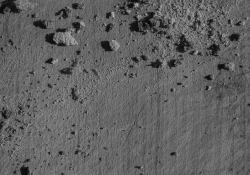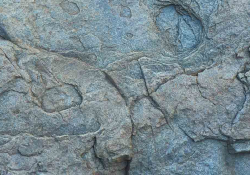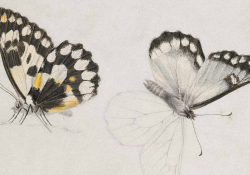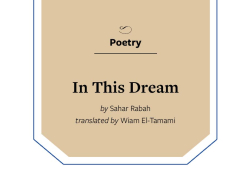Chikome Xochitl: A Poem in Seven Parts
Translators’ Note
Juan Hernández Ramírez describes both Nahuatl and Spanish as mirrors for his writing: “sirven de espejo, kewak se teskatl.” He does not write solely in one language, but rather both Nahuatl and Spanish perform together to create the pastiche of images in his poetry. The title of his book is indicative of this, as Juan writes Chikome Xochitl as two words, which correspond syntactically with the Spanish “Siete Flor” (Seven Flower). In Nahuatl it is more common to write this as one word, Chikomexochitl. This mutual influence between exceptionally distinct languages poses unique challenges to (or, better stated, adventures in) translation, as the translator must sift through distinct versions of the poems in each language.
For example, in the very first lines, the Nahuatl states Makuilxochitl kipatlaua imamal (Makuilxochitl spreads out her load on the ground) and in Spanish Su manto extiende Macuilxochitl (Macuilxochitl extends her shawl). The meaning in Nahuatl conveys imagery related to the loads of corn carried in maize ceremonies and laid out in offerings, whereas the version in Spanish paints the image of a sacred woman unraveling and extending her shawl to show her beauty. Informed by both meanings, we translated this as “Makuilxochitl unloads her shawl.” These rich distinctions add to the challenges already posed by any translation, especially in attempting to translate references to concepts and contexts unfamiliar in English.
The translations that follow were completed in very close collaboration with Juan Hernández Ramírez. With his sensitive ear to rhythm and cadence, the author personally recommended changes to achieve the desired musicality. He agreed with us that “Corn Spike Flower” was aesthetically unappealing in English and opted for “Maize Flower” as the corresponding title translation for Miauaxochitl. Interestingly, he also added that this dissonance was indicative of a more remote relationship of English speakers with the corn crop. As he went on to describe, English lacks the xochitlajtoli (literally “flowery language” or also “maize language,” as corn is the paramount flower in Nahuatl) to describe each stage in the cultivation of life’s principal sustenance with the aesthetic force and reverence that Nahuatl achieves. Along with the author, we hope that this translation helps bridge that gap and gives a sense of that veneration for this sacred crop and in turn for the entire earth.
The sounds in the background are birds, which he often alludes to in his poetry.
Miauaxochitl / Maize Flower / Espiga de maíz
1
Ipan ueyatl axiuitik sintli
Makuilxochitl kipatlaua imamal.
Kueponi miauatl.
Xali xochitl tiokuitlatik.
In ajuechkali
moxochitlakentijtok.
San eltok kuikatl tlatsotsontli.
Tender green corn upon the great sea
Makuilxochitl unloads her shawl.
The barbed corn blooms.
Gilded sand flower.
The house of dew
is dressed with flowers.
Only hymns and holy melodies.
Sobre el verde mar del maíz
su manto extiende Macuilxóchitl.
Brota la espiga.
Dorada flor de arena.
La casa del rocío
está vestida de flores.
Prevalece la música y el canto.
2
Tlilelemeka tonatij itsonkal
ipan sintli itlakayo.
Moxochiotlaltok Xilonen.
Pankistok siltik tlilelemektli.
Tlixochitl
toselik nakayo.
Ketsalxochimej kali.
The sun’s hair flames
over the body of maize.
Xilonen has blossomed.
The small-grained flame has sprung.
Flower of fire
our tender flesh.
House of precious flowers.
Arde la cabellera del sol
sobre el cuerpo del maíz.
Xilonen ha florecido.
La fina llama ha brotado.
Flor de fuego
nuestra tierna carne.
Casa de preciosas flores.
3
Chichiltik yayauik, chipauak, kostik
ikuetlaxo itlapoyauilis.
Tlen sintli tlayoli.
Ika xochitl mokuachijchijtok Senteotl.
Kuika miauatototl.
In chalchiuitl uitsitsilij,
ika xochitl moiuintia.
Red, black, white, yellow
the hues of her skin.
Choice kernel of corn.
Centeotl adorns her head with flowers.
The blossoming maize flower sings.
The jaded hummingbird,
drunken with flowers.
Amarillo, blanco, negro, rojo,
los matices de su piel.
El grano de maíz.
Centeotl, de flores está adornado.
Canta el pájaro espiga.
El colibrí de jade
se embriaga con las flores.
4
Kostik xochitl tlaixpaj.
Kantelaj tlauili. Kopalij ipokyo.
Tokistli tiochiualistli.
Tlali, se uinoj tlatsikuintli,
inik tlakatl seyok.
Xochimej, inik matlaeli.
Tlapojtok tlali, tlaoli kiselia.
Yellow flowers on the altar.
Candlelight. Copal smoke.
Sowing consecrated.
For earth, one offering of drink,
for man, another.
For abundance, flowers.
Earth open, it receives the choice seed.
Altar de flores amarillas.
Luz de velas. Humo de copal.
Rito de la siembra.
Un trago de aguardiente a la tierra,
otro para el hombre.
Para la abundancia, flores.
La tierra abierta, recibe la semilla.
5
Ipan youali tlakoyoyan kochki,
ajuechtli kiauitl issa.
Sintoktli.
Ipan kalejekatl yoltok.
Ipan tlauiltlalpan moskaltia,
xochiketsal ikuaxanko.
Xoxoktik xiuitl papalotl.
It slept in night’s furrow.
Rain’s dew awakes.
The corn stalk.
It lives in the wind’s house.
It grows in the land of light,
in Xochiquetzal’s bossom.
Green leaves like a butterfly.
Ha dormido en el lugar de la noche,
despierta bajo la lluvia del rocío.
La mata de maíz.
Vive en la casa de los vientos.
Crece en la tierra de luz,
regazo de Xochiquetzal.
Mariposa de hojas verdes.
6
Ketsaltototl kitlalana ipatlanil,
uiuipika sintli ixouiyo.
Ipan xoxouik xopantla tlali
tlen tlauili kuauitl moskaltia.
Kuikaya Xochitototl.
Tlapouij xiuimej
ipan yolistli.
The quetzal lifts into flight,
the maize leaf shudders.
In the green earth of rainy season
the tree of light grows.
The flower bird already sings.
Leaves open
to life.
Alza su vuelo el quetzal,
la hoja del maíz se estremece.
En la tierra verde-primavera
crece el árbol de la luz.
Ya canta el pájaro flor.
Las hojas se abren
a la vida.
7
Ipan tonatij ichaj yoltok.
Tlen yolistli tiokuitlatl yoltok,
kostik sintlayoli.
Xoxoktik mestli xiuimej
itsalaj tiotlatik tlauili uiuipikaj.
Tsaktok xochikoskatl.
Patlantok uitsitsilij.
Corn-child lives in the sun’s house.
Life’s living gold,
yellow seed of corn.
Green moon leaves
tremble beneath the afternoon light.
The necklace of flowers is complete.
The hummingbird has flown.
Vive en la casa del sol.
El oro vivo de la vida,
dorada semilla de maíz.
Las hojas verde-luna
tiemblan bajo la luz atardecida.
Se ha cerrado el collar de flores.
El colibrí ha volado.
Translations from the Huastecan Nahuatl and Spanish
By Adam W. Coon with David Shook
The Essential Context of Chikome Xochitl
The title Chikome Xochitl (Seven Flower) is a direct reference to the corn deity. Huastecan ceremonies represent Chikomexochitl with two sacred figures, a boy and a girl, each made from three to four cornhusks bound together and dressed in traditional clothing. Xilonen is xilotl (in Spanish jilote or “green spike of maize”) and refers to when the kernels of Chikomexochitl are soft and just beginning to bud. Xilonen also constitutes a pre-Columbian reference to the feminine side of Cinteotl (“maize god,” also spelled Centeotl). In the fifth poem, Xochiquetzal (“flowery quetzal bird” or “flowery preciousness”) is a pre-Columbian allusion to the patron goddess of the arts and complements the flowery images to describe corn.
The house of flowers, xochikali, is an actual Huastecan sanctuary that receives Chikomexochitl ceremonies. Among other meanings, the number seven of Chikomexochitl refers to seven staple crops that are the friends of the main staple corn. Yellow flowers on the altar in poem 4 allude to the flower sempoualxochitl (twenty flower). It is the only sacred flower used in ceremonies both for the dead and the living, such as in maize ceremonies asking for life to fill the cultivated fields.
Makuilxochitl (Five Flower), a pre-Columbian reference to a female Nahua poet from the fourteenth century and the patron god of writing and painting, continues the combination of different numbers with xochitl. These number combinations underscore maize’s relationship to literary production (as particularly seen in allusions to the famed in xochitl in kuikatl, “flower and song,” translatable also as “corn and song”). Within Chikome Xochitl and much Nahua literature, maize is central to aesthetic and life perspectives. The rows of maize in the fields constitute a common metaphor for lines on a page, and the smoke from incense are messages written on the air. The xochitlatsotsontli (flowery music) alluded to in the first poem with San eltok kuikatl tlatsotsontli (Only hymns and holy melodies) are a repertoire of sacred music played only in ceremonial spaces. Each essential element of the earth—such as maize, water, wind, fire, and the sun—has its own unique melody. These writings on the ground and wind paint a space in which one reverences Mother Earth and seeks to treat everyone with that respect. Hernández Ramírez seeks to transmute that textual landscape into his poetry.











